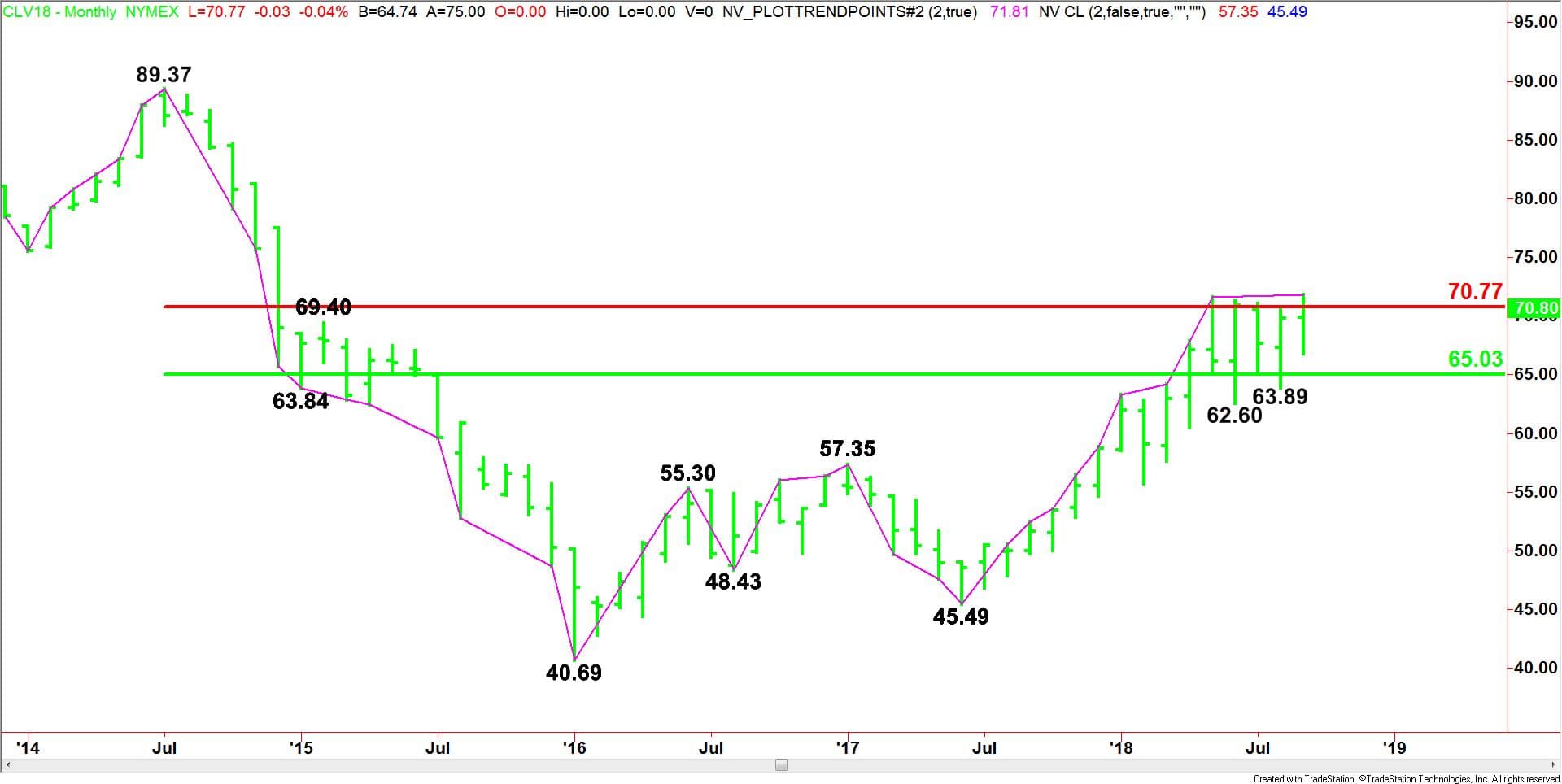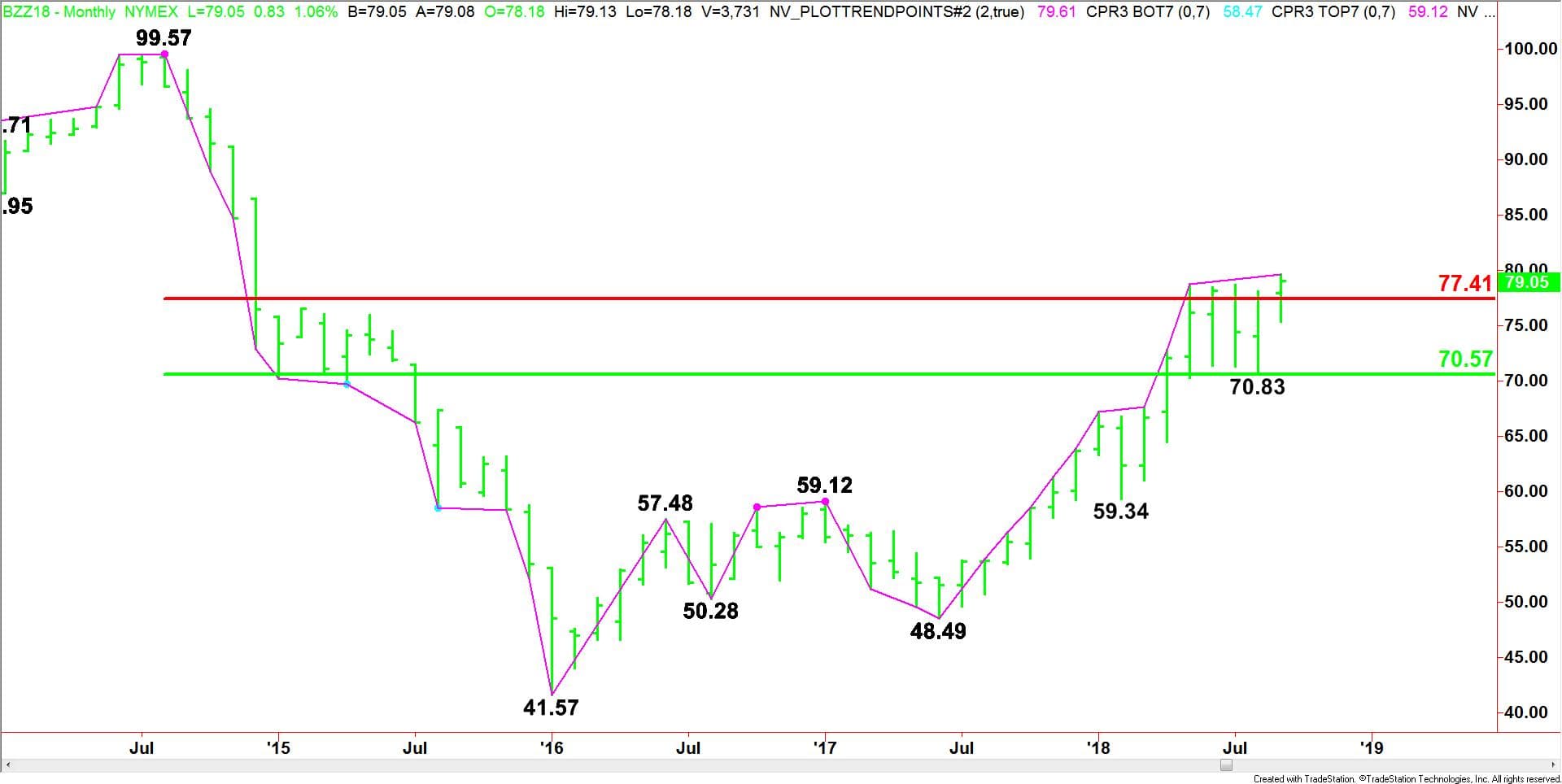U.S. November West Texas Intermediate and international-benchmark December Brent crude oil are poised to close higher for the week. Furthermore, both futures contracts are in a position to close on the bullish side of a major technical retracement zone. This will send a signal to traders that the buying is getting stronger.
If you look at the longer-term charts, you’ll see that the battleground since May has been the retracement zones. This is because trading inside a 50% to 61.8% retracement zone typically indicates a balanced market. The rally has been supported by concerns over supply due to the looming sanctions on Iran which are expected to begin in November. The upside, however, has been limited by expectations that increased production from Saudi Arabia and its allies would take care of any supply short-falls.
However, the narrative may have changed this week when Bloomberg reported, citing unnamed Saudi sources, that the kingdom was currently comfortable with prices above $80 per barrel, at least for short-term. Bloomberg also said that while Saudi Arabia had no desire to push prices higher than $80, it may no longer be possible to avoid it.
The news raised the ire of President Trump who called on OPEC to “get prices down now!” ahead of this weekend’s meeting of major oil exporters. At this meeting in Algiers, OPEC members are unlikely to push for an agreement to raise crude output, which means the forces of supply and demand could lead to a breakout…
U.S. November West Texas Intermediate and international-benchmark December Brent crude oil are poised to close higher for the week. Furthermore, both futures contracts are in a position to close on the bullish side of a major technical retracement zone. This will send a signal to traders that the buying is getting stronger.
If you look at the longer-term charts, you’ll see that the battleground since May has been the retracement zones. This is because trading inside a 50% to 61.8% retracement zone typically indicates a balanced market. The rally has been supported by concerns over supply due to the looming sanctions on Iran which are expected to begin in November. The upside, however, has been limited by expectations that increased production from Saudi Arabia and its allies would take care of any supply short-falls.
However, the narrative may have changed this week when Bloomberg reported, citing unnamed Saudi sources, that the kingdom was currently comfortable with prices above $80 per barrel, at least for short-term. Bloomberg also said that while Saudi Arabia had no desire to push prices higher than $80, it may no longer be possible to avoid it.
The news raised the ire of President Trump who called on OPEC to “get prices down now!” ahead of this weekend’s meeting of major oil exporters. At this meeting in Algiers, OPEC members are unlikely to push for an agreement to raise crude output, which means the forces of supply and demand could lead to a breakout to the upside. Going into the meeting, OPEC members will face pressure to prevent a spike in prices and most of this pressure is likely coming from the White House.
U.S. President Trump weighed into the debate via Twitter on Thursday, urging OPEC to cut prices.
“The OPEC monopoly must get prices down now!,” Trump said.
“We protect the countries of the Middle East, they would not be safe for very long without us, and yet they continue to push for higher and higher oil price! We will remember.”
While Trump’s tweet may have fueled a short-term sell-off on Thursday, sellers did not follow-through to the downside on Friday, suggesting investors are going to wait for OPEC’s decision over the week-end to determine the direction of the market over the near-term.
Technical Analysis
Monthly November West Texas Intermediate Crude Oil Technical Analysis

(Click to enlarge)
The main trend is up according to the monthly November WTI Crude Oil chart. The trend has been up since October 2016. After trading mostly sideways since May, the futures contract reaffirmed the uptrend this month when it took out the May top at $71.63.
The minor trend is also up. A trade though $63.89 will change the minor trend to down. This will also shift momentum to the downside.
The monthly main range is $89.37 to $40.69. Its 50% to 61.8% retracement zone is $65.03 to $70.77. This zone has been acting like support and resistance since May, but the price action this month suggests the market may be getting ready to breakout to the upside.
A sustained move over $70.77 will signal the presence of buyers. Look for a surge to the upside if this move attract enough aggressive buyers. Falling back inside $70.77 to $65.03 will indicate the market is not ready to rally. This can lead to further consolidation.
Look for a major shift in momentum if $65.03 fails as support.
Monthly December Brent Crude Oil Technical Analysis

(Click to enlarge)
The main trend is up according to the monthly swing chart. Upside momentum is beginning to pick up now that buyers have taken out the May top at $78.72. The monthly chart indicates there is no resistance until $99.57. This means we are looking at a momentum driven market.
The minor trend is also up. Its trend will change to down if sellers take out the last minor bottom at $70.83. This move will also shift momentum to the downside. This is essentially the trigger point for an acceleration to the downside.
The main range is $99.57 to $41.57. Its 50% to 61.8% retracement zone is $70.57 to $77.41. A sustained move over $77.41 will indicate the presence of buyers. If they can create enough upside momentum, we could see an acceleration to the upside.
Falling back inside $77.41 will indicate that the selling is greater than the buying at current price levels. It won’t signal a change in trend but it could lead to further consolidation inside $70.57 to $77.41. A break back under $70.57 will signal a major shift in momentum.
Conclusion
The greatest challenge for traders at this time is determining the sweet spot for crude oil. The market’s long-held supposition has been that Brent crude between $70 and $80 was OPEC’s target. However, reports this week said that Saudi Arabia is now comfortable with Brent at $80.
Recent market forces have put Brent in a position to challenge the $80 level and the rally into this level has been pretty smooth, suggesting little opposition to the area. Traders are primarily basing their buying decisions on concerns of supply shortages from looming U.S. sanctions against Iran, which are set to take effect in November, strong seasonal demand and the idea that spare capacity is falling sharply.
Trump’s tweets came as surprise to market participants on Thursday, which led to the sell-off, but they may not be enough to overcome the current forces in the market until we know more about the amount of crude oil that will be removed from the market because of the Iranian sanctions.
As long as the focus remains on the likely supply impacts of U.S.-led Iran sanctions, the bias should continue to be to the upside. The $80 level for Brent seems to be the swing number. The decision for speculators will be whether to drive the market through this level, or settle into the $70 to $80 range.
















